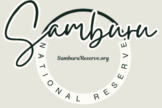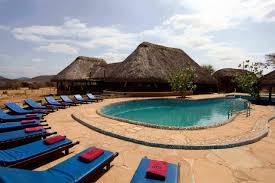1. Introduction
Samburu National Reserve is one of Kenya’s most evocative safari destinations — a semi-arid wilderness of rugged hills, acacia woodlands, and the winding Ewaso Ng’iro River, which sustains an astonishing diversity of wildlife. Covering about 165 km², it borders Buffalo Springs to the south and Kalama Conservancy to the north, forming part of the greater Samburu–Buffalo Springs–Shaba ecosystem.
Camping in Samburu offers a rare chance to experience this landscape intimately — sleeping under a vast northern sky, listening to elephants rumble across the river, and waking to the call of hornbills at dawn.
The reserve is managed by the Samburu County Government and offers both public and special (private) campsites.
2. Why Camp in Samburu
Camping in Samburu is ideal for travelers who value solitude, nature, and adventure over luxury.
- Rich wildlife: Samburu is home to all the big predators (lion, leopard, cheetah) and the region’s unique dryland species — the reticulated giraffe, Grevy’s zebra, gerenuk, Beisa oryx, and Somali ostrich.
- Scenic setting: All campsites are located along or near the Ewaso Ng’iro River, ensuring dramatic landscapes and abundant game viewing.
- Flexibility: You can choose between serviced public camps or secluded special camps for full privacy.
- Authentic bush experience: Camping here feels genuinely wild — most sites are unfenced, with wildlife moving freely around your tent.
3. Types of Campsites in Samburu
Among the several accommodation options in Samburu, Samburu NR offers two main categories of campsites:
Public Campsites
- Open to all visitors on a first-come, first-served basis.
- Simple but functional (pit latrine, cleared area, some water access).
- Managed by rangers at the main gate.
Special Campsites
- Must be reserved in advance through the Samburu County Council.
- Exclusive use for groups, mobile safari operators, or self-drive campers wanting privacy.
- No facilities; campers must be fully self-sufficient.
7. Main Campsites in Samburu National Reserve
🏕️ 1. Samburu Public Campsite (Main Riverside Site)
Location: Near the Ewaso Ng’iro River, about 1 km from the main ranger post.
Description: The most popular campsite in Samburu. Flat, shaded by large acacia and doum palms, and close to the river where elephants and buffalo frequently drink.
Facilities: Basic pit latrine, open fire area, nearby ranger post, limited water (non-potable).
Cost:
- Non-resident camping: USD 35 per adult per night
- Resident camping: KES 500 per adult per night
- Children (5–17 years): Half rate
Booking: No advance reservation required. Pay at the gate upon entry.
Highlight: Superb river views and easy access to the main game drive circuits.
Caution: Unfenced — elephants and baboons often wander through camp.
🏕️ 2. Kubi Panya Special Campsite
Location: South of the Ewaso Ng’iro River, near the Maji ya Chumvi river area.
Description: A secluded site favored by small private groups and mobile safari operators. Offers total privacy surrounded by bush and rocky outcrops.
Facilities: None — visitors must bring their own tents, water, and sanitation setup.
Cost:
- Site fee: USD 40 per adult per night (non-resident)
- Residents: KES 1,000 per adult per night
Booking: Must be booked in advance through the Samburu County Council offices or via your tour operator.
Highlight: Ideal for professional photographers or groups seeking isolation.
Caution: No water nearby — ensure you bring sufficient supplies.
🏕️ 3. West Gate (Uaso Bridge) Campsite
Location: Near the historic Uaso Nyiro Bridge at the western entrance (West Gate).
Description: A scenic open site on elevated ground overlooking the Ewaso River. Offers spectacular views of sunsets and elephants bathing below.
Facilities: Pit latrine, ranger presence, fire circle.
Cost:
- Non-residents: USD 35 per adult per night
- Residents: KES 500 per adult per night
Booking: Pay on arrival; no advance booking required.
Highlight: Excellent birdwatching — hornbills, storks, and bee-eaters nest nearby.
Caution: Watch for crocodiles and hippos when near the river.
🏕️ 4. Koitogor Special Campsite
Location: Near the base of Koitogor Hill, one of Samburu’s most iconic landmarks.
Description: A peaceful site surrounded by scenic hills and open savannah, ideal for mobile operators or adventurous travelers.
Facilities: None — completely wild.
Cost:
- Non-residents: USD 40 per adult per night
- Residents: KES 1,000 per adult per night
Booking: Advance booking required through the Samburu County Council Tourism Office.
Highlight: Sweeping views of the Koitogor and Ololokwe ranges, excellent for sunrise photography.
Caution: Remote — best for groups with full self-sufficiency.
🏕️ 5. Ngare Mara Special Campsite
Location: Eastern side of the reserve near the Ngare Mara River tributary.
Description: One of the quieter special camps, rarely used and surrounded by thick acacia forest. Wildlife often passes through this corridor between Samburu and Buffalo Springs.
Facilities: None.
Cost:
- Non-residents: USD 40 per adult per night
- Residents: KES 1,000 per adult per night
Booking: Advance booking required. Confirm with ranger post for accessibility, especially in the rainy season.
Highlight: Great for birdwatching and privacy.
Caution: The road can be rough after rain; 4×4 essential.
🏕️ 6. Umoja Women’s Village Campsite
Location: Just outside Samburu gate, next to the Umoja Women’s Cultural Village.
Description: A community-run campsite supporting Samburu women. Offers secure camping with cultural engagement opportunities.
Facilities: Toilets, showers, restaurant, and small bandas available.
Cost:
- Camping: USD 20 per person per night
- Bandas: USD 40 per person per night
Booking: Can be reserved directly by phone or on arrival at the gate.
Highlight: Safe, family-friendly, and ideal for travelers interested in community tourism.
Caution: Outside the park boundary (park fees paid separately).
🏕️ 7. Yare Camel Camp
Location: About 5 km from Archer’s Post on the main road toward the reserve.
Description: A rustic community camp run by a local Samburu family. Offers camel safaris, traditional dinners, and guided walks.
Facilities: Showers, toilets, restaurant, camping grounds, bandas, and basic accommodation.
Cost:
- Camping: USD 25 per person per night
- Camel safari (optional): USD 20 per person per hour
Booking: Call ahead or book on arrival.
Highlight: Combines camping with cultural immersion.
Caution: Located outside the reserve gates, so you’ll still need to pay park entry separately.
5. How to Book a Campsite in Samburu
Booking Options
- Through Samburu County Government Offices (Maralal or Archer’s Post)
- Contact the Tourism Department under the Samburu County Government.
- Payment can be made in cash, M-Pesa, or via operator invoice for special campsite reservations.
- You’ll receive a written permit showing your assigned site and dates.
- Through Tour Operators
- Most licensed safari operators (such as Kambu Campers or local guides) can pre-book special campsites on your behalf.
- Operators handle logistics, rangers, and payments.
- At the Gate (Public Campsites)
- For public camps, no prior booking is needed. Pay park entry and camping fees at the main gate (Samburu or Archer’s Post).
Required Information for Booking
- Full name and ID/Passport number
- Number of guests
- Dates of stay
- Vehicle registration number
- Type of campsite requested (public or special)
6. Park and Camping Fees (2025 Reference Rates)
| Category | Adult Non-Resident | Child Non-Resident | Adult Resident (Kenyan/EAC) | Child Resident |
|---|---|---|---|---|
| Park Entry (24 hrs) | USD 80 | USD 45 | KES 1,000 | KES 500 |
| Camping – Public Site | USD 35 | USD 20 | KES 500 | KES 300 |
| Camping – Special Site | USD 40 | USD 25 | KES 1,000 | KES 500 |
(Rates are payable at the gate or in advance via operator. Always confirm with Samburu County Government before travel.)
7. Practical Tips for Campers
- Water: Carry enough drinking water. River water may look clean but is not safe to drink.
- Security: All camps are unfenced. Always ask rangers for safety briefings and avoid walking at night.
- Firewood: Collect only dead wood or request a small bundle from rangers (fees may apply).
- Waste: Leave no trace — carry all waste out of the park.
- Lighting: Bring solar lamps or headlamps; there’s no electricity in the reserve.
- Vehicle: 4×4 is essential; the terrain is rough in places.
- Best Season: June–October and December–March are dry and ideal for camping.
- Communication: Mobile network (Safaricom) works in most parts of the reserve.
8. Suggested Itinerary
Day 1: Arrive from Nairobi, check in at Archer’s Post Gate, and camp at Samburu Public Campsite. Enjoy an afternoon game drive along the Ewaso River.
Day 2: Early morning game drive; visit Koitogor and Buffalo Springs crossing. Picnic lunch near the river.
Day 3: Optional visit to a Samburu cultural village, then break camp and depart for Buffalo Springs or Shaba.
9. Final Thoughts
Camping in Samburu National Reserve is an unmatched experience — raw, peaceful, and deeply connected to the rhythms of the wild. Whether you choose a simple public campsite shaded by acacias or a private special site under Koitogor Hill, you’ll be rewarded with unforgettable sunsets, starry skies, and the sounds of untamed Africa all around you.
Samburu’s campsites remind travelers of what safaris once were — simple, adventurous, and profoundly beautiful.

